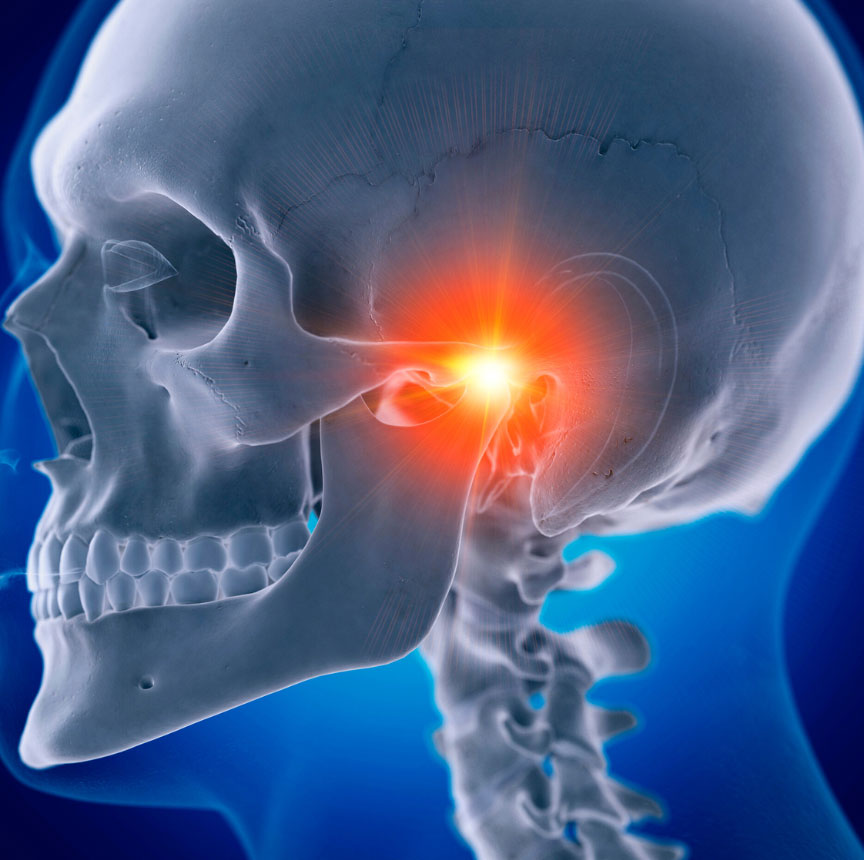
What is TMJ Temporomandibular Joint (TMJ)
The temporomandibular joint, often known as the TMJ, is an important part of the human anatomy that is responsible for the jaws' ability to move freely and effectively. This one-of-a-kind joint, which resembles a hinge and may be found on each side of the face, connects the jawbone to the skull, more specifically to the temporal bone. The temporomandibular joint (TMJ) is an important anatomical structure for humans because it enables us to perform a variety of vital functions, including chewing food, talking, and even yawning. The temporomandibular joint (TMJ) is home to an intricate network of muscles, ligaments, and cartilage that all collaborate to deliver the necessary range of motion and flexibility for the activities of daily life. It is important to note that problems associated with the TMJ frequently present themselves in the form of pain or discomfort, and the condition that encompasses these manifestations is known as temporomandibular joint disorder (TMD).
WHAT IS TMD-Temporomandibular Joint Disorders
Temporomandibular Joint Disorders (TMJ) are a set of problems that largely impact our jaw joint, which connects the lower jaw (mandible) to the upper jaw. This joint is called the temporomandibular joint (TM) (maxilla). These problems can cause a variety of symptoms, such as sounds like clicking, popping, or grating when the jaw is moved, limited jaw mobility, and discomfort or soreness in and around the joint. Other symptoms that can be caused by these condition include limited jaw movement. Although the precise reason for these problems is not always evident, there are a number of things that can contribute to their development. Some of these things include teeth grinding, arthritis, muscle stress, and injuries. TMJ issues can have a substantial impact on the quality of life of a person by making it difficult for them to do routine activities such as talking, chewing, or even yawning. Individuals will be better equipped to recognize the indications of TMJ problems and seek appropriate care from healthcare experts if knowledge and understanding of these complex conditions are increased. This will ultimately lead to improvements in the management and treatment of TMJ disorder.

Causes and effects of the symptoms
Temporomandibular joint disorders, often known as TMJ disorders, are a set of illnesses that affect the jaw joint and the muscles that surround it. These disorders frequently cause a great deal of pain and suffering. TMJ problems can manifest itself in a wide variety of ways, but the most typical symptoms include discomfort or tenderness in the jaw, facial pain, restricted jaw movement, and sounds like clicking or popping when the patient moves their jaw. Headaches, earaches, and dizziness are all potential side effects for certain individuals. The causes of TMJ disorders are diverse and can include a number of different factors, such as tension in the muscles caused by stress or poor posture, direct trauma to the jaw, arthritis, or dental issues that lead to an uneven bite. TMJ disorders can also be caused by a combination of these and other factors. It is essential to have a thorough understanding of the symptoms and possible causes of TMJ disorders in order to make an accurate diagnosis and select the most effective treatment. This will enable those who are afflicted to reduce their level of discomfort and enhance their overall quality of life.
What causes temporomandibular joint disorder?
Injuries to the jaw joints or the tissues that surround them are potential causes of TMJ dysfunction. Additional causes of TMD include the following:
A painful ailment that affects the temporomandibular joints and the tissues that surround them is referred to as TMJ dysfunction. Although while it may be the result of an accident or a traumatic experience, there are a number of other plausible causes. For instance, the strains that are placed on the teeth as a result of grinding one's teeth or clenching one's jaw can lead to inflammation of the ligaments and joint capsule of the jaw, which in turn can lead to TMD. TMD symptoms can also be brought on by arthritis in the jaw joint, which can be brought on by inflammatory diseases such as rheumatoid arthritis. In addition, your likelihood of having TMD may be increased by the presence of certain medical disorders, such as allergies and infections. Managing the discomfort associated with TMD and returning normal function can be accomplished with the support of a correct diagnosis and treatment plan, regardless of the underlying reason.

What Are Some Common Signs of TMJ Disorder?
Temporomandibular joint disease, more generally referred to as TMJ, is a common condition that impairs both the functionality and comfort of the jaw. It is sometimes referred to by its medical abbreviation. Those who have this disorder frequently struggle with a diverse set of symptoms, many of which can have a significant impact on their day-to-day life. Persistent pain or tenderness in the jaw area is one of the most prevalent indicators of TMJ. This discomfort may become more severe when performing certain actions, such as chewing food or talking. Also, some people may experience a clicking or popping sensation whenever they open or close their mouths, which can be an unsettling and uncomfortable sensation. Headaches, earaches, and a general sense of exhaustion in the face muscles are also possible symptoms of temporomandibular joint disorder (TMJ). In more extreme situations, an individual may have trouble opening or closing their mouth, which may lead to additional issues if the condition is not treated. If an individual is able to recognize these symptoms at an early stage and seek expert treatment, they may be able to significantly enhance their quality of life and lessen the distress that is frequently caused by this disease.
Disgnosis and Tests
Temporomandibular joint disease, often known as TMJ, is an extremely prevalent ailment that causes pain and discomfort by affecting the jaw and the face muscles. Due to the fact that the symptoms may be confused with those of other disorders, diagnosing and testing for this ailment requires a holistic approach on the part of medical specialists. In most cases, the first stages in evaluating probable TMJ difficulties consist of a comprehensive dental examination and a study of the patient's medical history. During an examination, the dentist will check the patient's range of motion while opening and closing their mouth, as well as the patient's jaw for any signs of pain or clicking sounds. It is also possible to use more advanced diagnostic procedures, including as X-rays, CT scans, or MRI scans, which offer a more in-depth imaging of the joint structure and make it possible to identify any underlying abnormalities that may be contributing to the patient's TMJ symptoms. The patient's quality of life can be improved, and the excruciating pain that is associated with this illness can be alleviated, if the disorder is diagnosed and tested as quickly as possible.
In what ways has TMJ been diagnosed?
Patients and medical professionals work together throughout the entire process of diagnosing temporomandibular joint dysfunction (TMJ). TMJ is an acronym that stands for temporomandibular joint disorder. It starts with a detailed assessment of the individual's medical history, then moves on to a full examination of the jaw muscles and joints, looking for any anomalies or discomfort while palpating the area. Dentists and oral surgeons may use a variety of diagnostic tools and imaging technologies, such as X-rays, CT scans, or MRI scans, in order to determine the underlying cause of a patient's persistent jaw pain, clicking, or limited movement in the jaw joint. These tools and technologies are used to identify the source of the problem. As the patient progresses through this multifaceted diagnostic process, they become educated on the underlying factors contributing to their symptoms. This allows them to work closely with their healthcare provider to determine the most effective therapeutic solutions that will restore comfort and function to the temporomandibular joint. TMJ can only be correctly diagnosed and effectively treated through the dynamic partnership of a patient and a healthcare professional, which eventually results in an improved quality of life for the patient.
What Kinds of Therapies are There to Choose From?
To our good fortune, there are a variety of treatments that can be used to assist in the management of this ailment. Medications, dietary adjustments, physical therapy exercises, and relaxation techniques are all examples of non-invasive treatments that may be helpful in reducing the pain associated with TMJ. In addition, dental procedures like bite plates or braces, which are used to realign the jaw in order to place it in the correct position, can be utilized to assist in doing so. Surgery may be required to rectify physical abnormalities and restore functionality in severe cases of temporomandibular joint disorder (TMJ). The entire treatment for TMJ should focus on providing pain relief while also restoring normal movement and functionality to the patient's jaw. This should be the case regardless of the severity of the impairment.
What are some instances of TMJ treatments that do not involve surgery?
The discovery of effective nonsurgical treatments for temporomandibular joint dysfunction (TMJ), also known as TMD, has the potential to greatly enhance the quality of life for people who suffer from this ailment, which can be extremely painful and incapacitating. The use of oral splints or mouth guards is one therapy option for TMJ disorder. These devices help to relieve pressure on the joint and reduce the amount of teeth grinding or clenching that occurs while a person sleeps. Together with the use of heat and cold therapy to reduce inflammation and pain, physical therapy exercises that are meant to stretch and strengthen the muscles in the jaw may also provide relief. In addition, medical professionals may suggest making adjustments to your lifestyle, such as adopting correct posture, learning relaxation strategies to handle stress, and altering your diet to include softer foods that put less tension on the jaw muscles. In the end, the usage of nonsurgical therapies for TMJ provides the opportunity to address the fundamental reasons of discomfort and assists folks in leading lives that are free of pain to a greater extent.
When Would You Want to Consider Having TMJ Surgery?
When seeking for a strategy to manage the symptoms of temporomandibular joint disorder (TMJ), many people initially consider non-invasive treatment alternatives, including as physical therapy, relaxation techniques, and over-the-counter drugs. However, if the condition is serious and the aforementioned treatments do not provide relief after a considerable amount of time has passed, surgical intervention may be required. In addition, if there is any damage that may be the cause of your TMJ pain, then surgery may be the best option to address the issue and offer long-term relief. This is because surgery can correct the issue at its source and remove the pain permanently. It is crucial that you discuss your options with your medical expert so that they can prescribe the best course of action based on the individual's circumstances. This is true regardless of the treatment strategy that you decide to pursue for your ailment.
How can I lower my chances of developing TMJ Disorder?
TMJ dysfunction can cause significant discomfort and interfere with daily life, not to mention financial burdens. The good news is that there are a few actions that can assist in lowering the probability of having this ailment. The jaw should be kept relaxed and the head should be held in an upright position when practicing proper posture, whether sitting or standing. In addition, preventative exercises like yoga, Pilates, or stretching can help maintain your jaw muscles supple and relaxed. These exercises can be done on a regular basis. It is also vital to pay attention to habits such as grinding your teeth or holding your phone between your shoulder and ear. These are behaviors that can impose additional stress on the temporomandibular joint, so it is crucial to be aware of them. Consuming foods that are easy to chew and avoiding products that are difficult to chew will also go a long way toward preventing this disease. Taking time out of your day to engage in activities that promote relaxation, such as deep breathing, can help reduce stress, which is a common factor in the involuntary jaw movements that are associated with TMJ condition.
When Is the Appropriate Time for Me to Get Treatment for TMJ Disorder?
If you have been suffering from discomfort in the temporomandibular joint for an extended period of time, it is highly recommended that you seek treatment as soon as possible. The symptoms of TMJ include pain in the face and jaw, discomfort in the jaw, and clicking noises emanating from the jaw when speaking or chewing. In order to avoid severe problems and additional pain in the future, it is critical to make a diagnosis of this health condition as quickly as possible and begin treatment as soon as feasible. In addition, symptoms may suggest a more serious disease such as arthritis or an infection and should not be neglected because of this possibility. Talk to a medical professional or a dentist in order to obtain an accurate diagnosis and a treatment strategy, if one is required. It is possible to live a healthy life and experience less discomfort if you have access to the appropriate expert assistance.
Is it possible for TMJ issue to go away on its own?
Disorder of the temporomandibular joint, more commonly referred to as TMJ, is a widespread condition that affects millions of people all over the world. The symptoms of this ailment include pain and discomfort in the jaw, trouble chewing, and perhaps even headaches or earaches. The subject of whether or not TMJ can disappear on its own is one that is asked by a significant number of patients. Although it's true that some cases of TMJ can go better on their own, this is not the case for everyone who has the condition. When assessing whether or not treatment is necessary, it is important to take into account both the severity of the condition and the factors that led to its development. Lesser cases may improve with time and self-care techniques, such as avoiding excessive use of the jaw, adopting a diet of soft foods, or applying ice packs to relieve inflammation. Milder cases of TMJ may also improve with self-care treatments. In more severe cases, it may be necessary to seek the assistance of a specialist such as a dentist or a physical therapist in order to address the underlying causes and design a treatment strategy that is specific to the problem. You will give yourself the best chance of treating this painful and often frustrating illness if you detect the symptoms of TMJ early on and swiftly address them. The key is to notice the symptoms of TMJ early on and promptly address them.
What can be expected in the absence of treatment for TMJ Disorder?
Disorder of the temporomandibular joint, more commonly referred to as TMJ, is a widespread condition that affects millions of people all over the world. The symptoms of this ailment include pain and discomfort in the jaw, trouble chewing, and perhaps even headaches or earaches. The subject of whether or not TMJ can disappear on its own is one that is asked by a significant number of patients. Although it's true that some cases of TMJ can go better on their own, this is not the case for everyone who has the condition. When assessing whether or not treatment is necessary, it is important to take into account both the severity of the condition and the factors that led to its development. Lesser cases may improve with time and self-care techniques, such as avoiding excessive use of the jaw, adopting a diet of soft foods, or applying ice packs to relieve inflammation. Milder cases of TMJ may also improve with self-care treatments. In more severe cases, it may be necessary to seek the assistance of a specialist such as a dentist or a physical therapist in order to address the underlying causes and design a treatment strategy that is specific to the problem. You will give yourself the best chance of treating this painful and often frustrating illness if you detect the symptoms of TMJ early on and swiftly address them. The key is to notice the symptoms of TMJ early on and promptly address them.
How do I eliminate TMJ issue completely from my life?
If you suffer from Temporomandibular Joint (TMJ) disease, you are aware of how frustrating and incapacitating the condition may be. This illness can have a substantial influence on your day-to-day life, including symptoms such as jaw pain and headaches. Yet there is no reason to give up hope because there are treatments that can get rid of TMJ disease for good. See a healthcare expert as your first step. They may suggest treatments such as physical therapy, dental appliances, or even surgery in severe cases. Nonetheless, don't discount the need of taking care of yourself. The implementation of strategies for stress management, the practice of excellent posture, and the performance of exercises that are specifically targeted can go a long way toward improving your condition. You may successfully beat TMJ condition and reclaim your life without being in continual pain and suffering if you take a holistic approach to treatment. This will allow you to regain control of your life.
